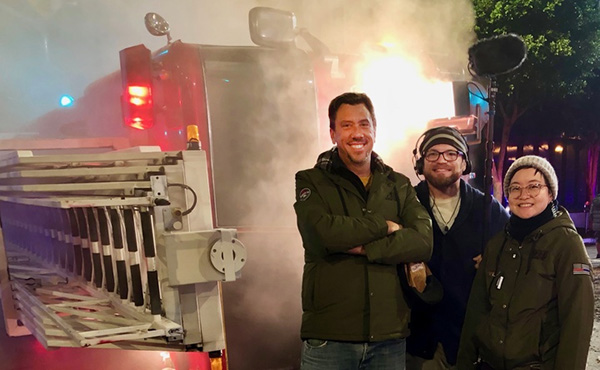“American Horror Story” recurring star Sarah Paulson, who is proactive about the role of audio in capturing her performances, brings her personal Lectrosonics SSM Digital Hybrid wireless transmitter to every shoot on the FX television network show.
Production mixer Brendan Beebe, CAS, adds that the show also employs Lectrosonics SMV and HMa transmitters, UCR411a receivers, and the IFB-T4 and IFB-R1B pairing for monitoring. “I first encountered Lectrosonics in, I think, 1996 or ’97,” he notes. “Warner Brothers used it exclusively, and with each new generation, it just got better. Then the Digital Hybrid technology just changed the whole game — it became the gold standard in Hollywood.”
According to Beebe, who started out as a driver for a sound rental company (“They hired me because I was the only guy who showed up wearing a tie,” he jokes), the first factor that makes Lectrosonic systems suited for AHS is dynamic range. “There are intimate scenes that explode into big drama on a dime,” he explains. “Sarah Paulson and Evan Peters might be the two most dynamic actors I’ve ever recorded in that respect — they can go from a whisper to a loud scream very naturally. But thanks to the gain range and the 30 dB limiters on the transmitters, I rarely if ever run into issues with clipping. Sarah carries her own SSM everywhere, as did Lady Gaga on the Hotel season.”
Beebe got creative with recording Lady Gaga’s turn as the vampire queen of a haunted hotel, and to record it all, Beebe got creative. “There was one scene going down a hallway where I asked her, ‘Are you going to whisper or scream here?’” he recalls. “She looked at me slyly and said, ‘You never know/’ That’s legit — an actor might decide right in the moment what works best for that scene. So, we flew two booms above her, each with an HMa plug-on transmitter on the mic. I set the gain on one between 40 and 45 for whispering, and the other between 12 and 18 to get any screaming. It was flawless. One mic or the other always had a signal the editors in post could use, so that became our way of working with her for a lot of scenes.”
When Beebe needs additional output power in difficult environments, he deploys SMV belt pack transmitters. “I always try to coordinate with other productions that might be in the same area,” he says, “but in L.A., we’ve gotten squeezed into pretty much the A1 frequency range, about 470 to 537 MHz. Now, combine that with the fact that AHS is pretty much a three-camera shoot all the time. Each camera has a Wi-Fi video transmitter on it, working around 1.9 GHz. These send picture to the monitors for the focus pullers. Then we have IFBs and comms, so it’s just this saturated field of RF before we record the first word of dialogue. If the 50-milliwatt setting on the SMVs isn’t getting me what I need, 100mW usually does. If things get really crazy, their ability to go up to a quarter-watt always saves the day.
“Lectrosonics’ reliability is just unprecedented,” he concludes. “Whatever the job, I know it’s just going to work and that as a sound guy, I’m going to have a good day. I just love the stuff.”




















